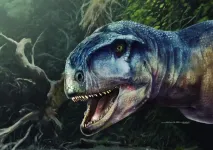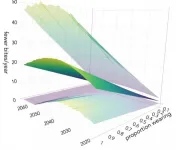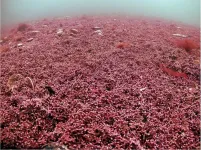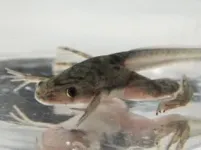Decellularized spinach serves as an edible platform for laboratory-grown meat
The veiny skeleton of a spinach leaf shows for the first time it can support the growth of artificial meat, a Boston College researcher reports
2021-03-31
(Press-News.org) Chestnut Hill, Mass. (3/31/21) -- Spinach, a cost-efficient and environmentally friendly scaffold, provided an edible platform upon which a team of researchers led by a Boston College engineer has grown meat cells, an advance that may accelerate the development of cultured meat, according to a new report in the advance online edition of the journal Food BioScience.
Stripped of all but its veiny skeleton, the circulatory network of a spinach leaf successfully served as an edible substrate upon which the researchers grew bovine animal protein, said Boston College Professor of Engineering Glenn Gaudette, the lead author of the new study. The results may help increase the production of cellular agriculture products to meet rising demand and reduce environmental costs.
"Cellular agriculture has the potential to produce meat that replicates the structure of traditionally grown meat while minimizing the land and water requirements," said Gaudette, the inaugural chair of BC's new Engineering Department. "We demonstrate that decellularizing spinach leaves can be used as an edible scaffold to grow bovine muscle cells as they develop into meat."
Earlier advances by Gaudette in this area garnered worldwide attention. In 2017, Gaudette and a multi-university team showed that human heart tissue could be cultivated on a spinach leaf scaffold, which was chosen because it offered a natural circulatory system that is nearly impossible to replicate with available scientific tools and techniques.
"In our previous work, we demonstrated that spinach leaves could be used to create heart muscle patches," said Gaudette. "Instead of using spinach to regrow replacement human parts, this latest project demonstrates that we can use spinach to grow meat."
Gaudette said the team, which included Worcester Polytechnic Institute graduate students Jordan Jones and Alex Rebello, removed the plant cells from the spinach leaf and used the remaining vascular framework to grow isolated cow precursor meat cells. The cells remained viable for up to 14 days and differentiated into muscle mass.
"We need environmentally and ethically friendly ways to grow meat in order to feed the growing population," said Gaudette, whose research is supported by New Harvest. "We set out to see if we can use an edible scaffold to accomplish this. Muscle cells are anchorage dependent, meaning they need to grab on to something in order to grow. In the lab, we can use plastic tissue culture plates, but plastic is not edible."
The researchers point out that the successful results will lead to further characterization of the materials and scientific processes to better understand how to meet consumer demand and gauge how large-scale production could be accomplished in accordance with health and safety guidelines.
"We need to scale this up by growing more cells on the leaves to create a thicker steak," said Guadette. "In addition, we are looking at other vegetables and other animal and fish cells."
INFORMATION:
[Attachments] See images for this press release:
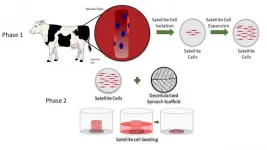
ELSE PRESS RELEASES FROM THIS DATE:
2021-03-31
Research published today in the peer-reviewed Journal of Vertebrate Paleontology describes a newly discovered species of dinosaur - named the 'one who causes fear', or Llukalkan aliocranianus.
Around 80 million years ago as tyrannosaurs ruled the Northern Hemisphere, this lookalike was one of 10 currently known species of abelisaurids flourishing in the southern continents.
A fearsome killer, Llukalkan was "likely among the top predators" throughout Patagonia, now in Argentina, during the Late Cretaceous due to its formidable size (up to five meters long), extremely powerful ...
2021-03-31
Early treatment with anti-VEGF injections slowed diabetic retinopathy in a clinical study from the DRCR Retina Network (DRCR.net). However, two years into the four-year study its effect on vision was similar to standard treatment, which usually begins at the onset of late disease. The intermediate findings published today in the JAMA Ophthalmology. The study was supported by the National Eye Institute (NEI), a part of the National Institutes of Health.
"While it is possible that preventive injections of anti-VEGF drugs may help protect vision in the longer-term, ...
2021-03-31
A new mathematical model suggests that the easing of lockdown must be accompanied by wider and more effective use of control measures such as facemasks even with vaccination, in order to suppress COVID-19 more quickly and reduce the likelihood of another lockdown.
The model, developed by scientists at the Universities of Cambridge and Liverpool, is published today in the Journal of the Royal Society Interface. It uses mathematical equations to provide general insights about how COVID-19 will spread under different potential control scenarios.
Control measures involving facemasks, handwashing and short-scale (1-2 metre) social distancing can all limit the number of virus particles being spread between people. These are termed ...
2021-03-31
With shark bites increasing in countries like Australia - scientists say the use of personal electronic deterrents is an effective way to prevent future deaths and injuries which could save the lives of up to 1063 Australians along the coastline over the next 50 years.
The research, published in scientific journal Royal Society Open Science, shows that while shark bites are rare events, strategies to reduce shark-bite risk are also valuable because they can severely affect victims and their support groups - with one third of victims experiencing post-traumatic stress ...
2021-03-31
Heart attacks in young adults are twice as likely to be fatal in those with inflammatory conditions like psoriasis, lupus or rheumatoid arthritis. That's the finding of a study published today in the European Journal of Preventive Cardiology, a journal of the European Society of Cardiology (ESC).1
At least 2% of people in Europe and worldwide have systemic inflammatory diseases, which often affect multiple organ systems. Many of these systemic inflammatory diseases are driven by autoimmunity, meaning the body's immune system attacks itself. Psoriasis is the most common and causes red, itchy, scaly patches on the skin, and can also cause inflammation in the joints. Rheumatoid arthritis leads to inflammation in joints of the hands and feet and in other organ systems. In systemic ...
2021-03-31
Red algae that grow in Cornwall's Fal Estuary are genetically unique, new research shows.
University of Exeter scientists studied the population genetics of Phymatolithon calcareum, a coralline red algal species that forms maerl beds in shallow coastal seas from Portugal to Norway.
Large maerl beds fulfil a similar role to tropical coral reefs, providing habitats and vital shelter for hundreds or even thousands of fish and invertebrates. These algae also play an important role in storing carbon.
The findings reveal genetic differences are "structured geographically", with slight variations between populations sampled from across this large geographic area.
However, maerl ...
2021-03-31
Human disturbance in urban environments makes some squirrels fail, but others perform better in novel problem-solving.
Unlike natural environments, urban areas have artificial buildings, traffics, less greenery and, most prominently, more humans. Despite these seemingly 'harsh' or stressful characteristics, some wildlife like the Eurasian red squirrel have chosen to settle down in urban environments, and they thrive. Urban wildlife often show higher behavioral flexibility and increased ability to solve novel problems, and thus can exploit new resources. However, which characteristics of urban environments influence animals' performance, and their relative importance, have remained ...
2021-03-31
Scientists have discovered a new genetic disease, which causes some children's brains to develop abnormally, resulting in delayed intellectual development and often early onset cataracts.
The majority of patients with the condition, which is so new it doesn't have a name yet, were also microcephalic, a birth defect where a baby's head is smaller than expected when compared to babies of the same sex and age.
Researchers from the universities of Portsmouth and Southampton found that changes in a gene called coat protein complex 1 (COPB1) caused this rare genetic disease.
Now the variant has been identified, it will help clinicians come up with targeted interventions to help patients and their families, also opening the door to screening and prenatal ...
2021-03-31
A new study examining how people with severe and profound intellectual disabilities resist activities while in care recommends that institutions improve training to help carers better understand non-verbal cues, as well as offer greater flexibility to allow individual preferences to take priority over institutional schedules.
The research, published in the journal Sociology of Health and Illness, investigated how people with limited language ability expressed their wishes and preferences, and how their support workers responded. It was carried out at a residential home and a day care centre in the UK.
The study, by Dr Clare Nicholson of St Mary's University, Twickenham, and Dr Mick ...
2021-03-31
In the run up to hibernation, grizzly bears go on a colossal binge, consuming as many calories as possible to get them through the long winter. Yet, little was known about how much energy the massive mammals use as they shamble around their rugged territories. 'Moving across the landscape in search of food can be a huge energetic expense for some animals', Carnahan says. Fortunately, the Washington State University Bear Research, Education and Conservation Center (WSU BREC), where Carnahan is based, is home to 11 bears, including four that formerly lived in Yellowstone National Park, so he and Charles Robbins (also at WSU BREC) decided to measure the animals' metabolic rates as they sauntered on the flat, and up and down gradients to find out how much ...
LAST 30 PRESS RELEASES:
[Press-News.org] Decellularized spinach serves as an edible platform for laboratory-grown meat
The veiny skeleton of a spinach leaf shows for the first time it can support the growth of artificial meat, a Boston College researcher reports

